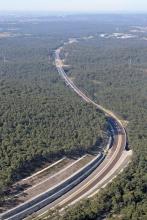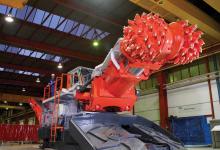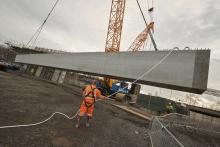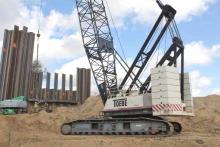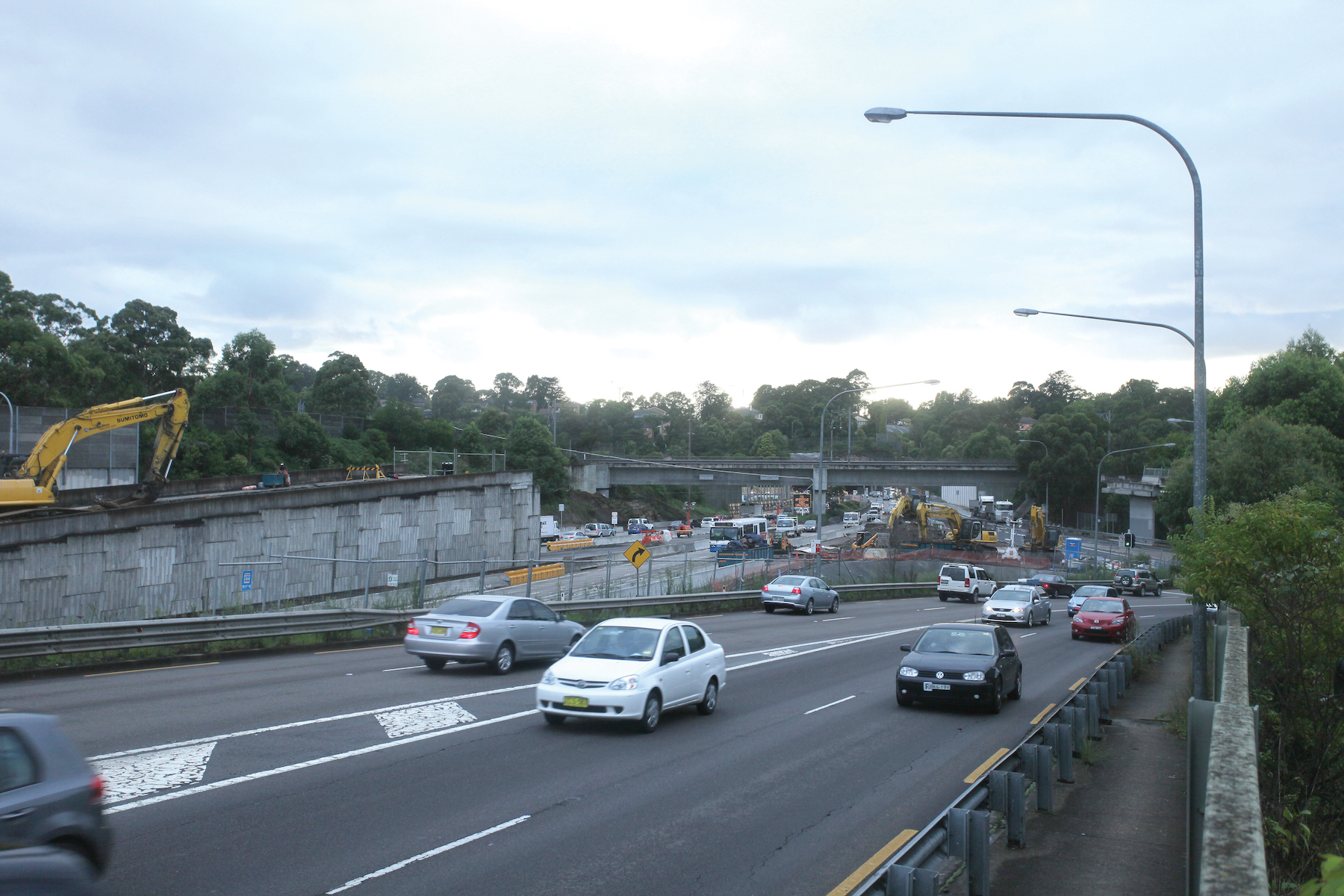
Sydney’s Hills M2 motorway is being widened while still carrying traffic and meeting tough environmental criteria
More than 100,000 vehicles and over 27,000 bus commuters use theThe Hills M2 Upgrade is one of many projects identified in the NSW Government's Metropolitan Strategy (reviewed March 2010) and the Metropolitan Transport Plan - Connecting the City of Cities (March 2010) to improve the efficiency of Sydney's transport network. These projects will contribute to achieving sustainable economic, social and environmental outcomes for Sydney into the future.
Linking Sydney’s North-West region to the lower north shore and the commercial business district, the Hills M2 is a crucial road freight and commuter route connecting the major employment hubs of Macquarie Park and Norwest Business Park.
KEY FACTS
Norfolk Tunnel facts:
Over 500 new lights and over 12km of new cabling were installed in the citybound tunnel.
17,000m3 of rock has been excavated from the citybound tunnel (12,500m3 inside and 4,500m3 outside the tunnel)
Over 50 workers work inside the tunnel each night across multiple disciplines @Over 40 properties are either directly above or adjacent to the tunnel and are potentially exposed to dust, air and ground borne noise
Work inside the tunnel is governed by strict EPA regulations
The Hills M2 Upgrade is widening the existing motorway between Windsor Road, Baulkham Hills and Lane Cove Road, North Ryde, and is delivering four new ramps to improve access to the motorway.
The project aims to provide efficient and integrated transport for the community of Sydney’s North-West with a reduction in traffic congestion during busy morning and afternoon periods. Journey times during peak AM hours are set to reduce by 15 minutes (40%), and by seven minutes (24%) in peak PM hours.
The Hills M2 Upgrade will also lead to the restoration of a 100km/h speed limit along the motorway westbound from Lane Cove Road to Beecroft Road, including through the Norfolk Tunnel. It will also provide new entry and exit points to improve access to the North-West from Windsor Road and Sydney's growing residential and business centres in Macquarie Park.
Since the upgrade began, extensive progress has been made on ramp, bridge, road widening and tunnel works. The first major milestone for the project was marked in July 2012 by opening the new west-facing Windsor Road on and off ramps.
This major milestone was delayed by unusually high rainfall since October 2011 but, since opening, the on and off ramps have been providing commuters with travel time-saving benefits.
The new Windsor Road ramps are an important new connection between Sydney’s rapidly growing West and North-West.
They offer direct access to the Hills M2 for motorists travelling between the Hills district, Parramatta and Sydney’s West and North-West.
The ramps provide new access to the Sydney Orbital Network for thousands of motorists; by using the new ramps; some motorists could skip traffic lights and save up to 40 minutes off their weekly commute.
The new westbound on-ramp allows motorists heading west to enter the Hills M2 at Windsor Road, taking congestion off local roads. Additionally, the new citybound off-ramp provides an exit point to access Baulkham Hills, Northmead and Parramatta.
Up to 100 people a day were working on the Windsor Road ramps during peak production, with over 120 night shifts undertaken during the course of the works. A total of 160 piles were driven for the new foundations, 1.1km of new drainage lines and 100 drainage pits were installed, and 150,000tonnes of reinforced earth material was placed.
The installation of the new ramps also led to 35,000tonnes of spoil being removed from the site; the fitting of 7,000m2 of new retaining wall panels; the pouring of 8,500tonnes of concrete; the laying of 4,000tonnes of asphalt; and the installation of 35,000 reinforcing straps behind new retaining walls.
The Norfolk Tunnel is the first operating road tunnel to be widened in Sydney. It is being widened to provide three lanes and a breakdown lane in each tunnel tube.
Excavation works in the citybound tunnel started in November 2011 and could only take place during periods of low traffic on the weekends and at night to ensure all lanes of traffic are available during weekday peaks.
Most of the tunnel widening work was done by two S200 Mitsui low profile road headers which grind the sandstone walls of the tunnel to the new width. The excavated sandstone was picked up by a rotating arm and conveyor belt that fed it to waiting trucks for transport to the main compound for recycling.
The two road headers cut into the outer wall of the tunnel parallel to the traffic. Every two metres that the road headers progressed, rock bolts were installed in the new roof structure to support it; every eight metres the roof was shotcreted to prevent loose material from falling. Around 1,750tonnes of rock were excavated each weekend.
Also used in the crucial tunnel widening phase of the project were two
Widening of the citybound tunnel was completed in July 2012, including commissioning of the new mechanical and electrical infrastructure including lighting, controls and deluge system.
In early August 2012, new temporary traffic conditions were implemented inside the Norfolk Tunnel to allow the westbound tunnel widening to begin.
Two lanes are now available in each direction in the citybound tunnel. A third westbound lane is available in the westbound tunnel during the weekday afternoon peak between 2pm and 8pm. These traffic conditions will remain in place for the anticipated eight month duration of the westbound tunnel widening works.
Current work inside the tunnel involves relocating existing services and strengthening the existing roof structure by placing approximately 1,500 rock bolts.
On completion of all work, the Norfolk Tunnel will provide three general traffic lanes and one breakdown lane in each direction.
Over 500 new lights and over 12km of new cabling were installed in the citybound tunnel. 17,000m3 of rock has been excavated from the citybound tunnel (12,500m3 inside and 4,500m3 outside the tunnel).
One of the biggest challenges for the project over the past twelve months has been maintaining traffic flow during lengthening and widening work on the ten bridges on and over the motorway.
Modifications to the Hills M2 bridges over Darling Mills Creek, Yale Close and Devlins Creek and overbridges at Beecroft Road and Christie Road will be completed in the coming months. Work on Barclay Road and Murray Farm Road bridges will continue later into the year.
To ensure the project is delivered safely and to a high standard, the team is relying on technical innovations and advances in impact mitigation. Major challenges to date have included the implementation of bridge lengthening and widening works without disrupting live traffic above and underneath; widening an operational tunnel at night and weekends and ensuring its readiness for operation each morning; working in narrow/restricted work zones with extensive traffic management requirements; and ensuring suitable site access for material delivery and safe and efficient works.
The modifications to the Beecroft Road Bridge and Murray Farm Road Bridge were required to allow widening of the Hills M2 carriageways by one lane in each direction.
This is being achieved by modifying the support conditions of both bridges while still maintaining vehicle and pedestrian access.
Previously a three span horizontal curved post tension structure, the Beecroft Road Bridge is being turned into a two span structure, with increased span lengths achieved by replacing the existing two rows of piers with a single central row of piers in the widened motorway median. The Murray Farm Road Bridge is being lengthened on the northern side by around 8m with the construction of a new abutment and replacement of the existing pier between the carriageways.
For its modifications to both bridges, Leighton Contractors Hills M2 Upgrade team won the inaugural Roads and Maritime Services (RMS) Construction Quality Award in the ‘Design and/or Technical Services’ category. Key to the win was said to be the project’s innovation in design and use of super-flowable concrete mix design development with industry participation in conducting trials.
The project’s quality system, quality training, sub-contractor management and end product quality were also recognised for improving the construction quality outcomes and providing RMS with a low maintenance, high-quality product.
Intelligent transport systems are being maintained along the Hills M2 to ensure the continued operation of the motorway during construction. Early in the project temporary ITS was installed along the motorway corridor, while permanent work, including under boring and trenching, will be ongoing until late 2012.
The Hills M2 was also converted to cashless toll collection on 30 January, 2012. As a result there is no queuing at bottlenecks on the motorway, including Pennant Hills Road interchange and the main toll plaza. Further benefits of the introduction of cashless toll collection include improved safety for motorists by reducing lane changing, merging and weaving at cash booths, and reduced vehicle noise at the toll plazas.
The signposted speeds through tolling points will be increased to 100km/h once the Hills M2 Upgrade is complete.
Construction works to convert to cashless tolling involve the introduction of a new toll reader, realignment of the traffic lanes and barriers, and the removal of the toll booths at the main toll plaza and Pennant Hills Road on and off-ramps. The new single span gantry at the main toll plaza is being installed around 300m west of the current toll plaza.
The Hills M2 Upgrade is the most substantial upgrade of existing infrastructure in the heart of Sydney's urban corridor.
When working in such established urban corridors all care must be given to ensure impacts on the adjoining community and environment are minimised.
Tower cranes were set up for widening of the two of the three motorway viaducts at Darling Mills Creek and Terrys Creek. The tower cranes minimised project footprint and vegetation clearing requirements. At Darling Mills Creek Bridge, the tower crane assisted in construction of four new 30m piers to widen the citybound carriageway by 4m.
In February 2012, the old Beecroft Road bus ramp over the motorway was demolished to allow construction of an additional lane in each direction on the motorway. This work was undertaken over three weekends from 8pm on Fridays to 5am on Mondays.
Consultation was undertaken with over 100 of the closest households to understand their views on the number of weekends work was to be conducted over and the hours of work. The feedback provided allowed the Environmental Protection Agency (EPA) to issue a Licence variation reflective of the Community Consultation outcomes. Residents in over 70 of the closest properties were temporarily relocated while the bridge was demolished by six excavators with hammers continuously over the weekend. Minimal complaints were received in respect to this work.
The demolition of the old northern abutment of the Murray Farm Road Bridge was acknowledged by RMS for its technical challenge and for effective consultation with the community. The high noise impact work was delivered with no complaints from nearby residents despite rock breaking work continuing throughout the night over two shifts.
The result was due to the team ensuring widespread awareness and understanding of the works. The team installed VMS signage, distributed 500 notifications, door knocked over 50 properties, and offered temporary relocation to sensitive receivers in closest proximity to the works.
To reduce the impacts of the tunnel work, noise reducing curtains have been installed at both ends of the tunnel during widening work. These curtains are made of sound absorbing material and cover each end of the tunnel to reduce construction noise impacts on the surrounding residences. The curtains are open during the day and closed at night when work is being carried out.
Temporary noise walls have been installed at various locations along the motorway. The temporary walls are on the motorway side of the existing noise walls. The temporary noise walls are between 2.4m and 4.5m high and made of timber and steel. Once the temporary noise walls are built, the existing noise walls are progressively removed in sections to allow for widening work to take place. Where temporary noise walls cannot be constructed new noise walls are built simultaneously as existing noise walls are being removed.
A number of key Hills M2 Upgrade elements are due to be either finished or started between October and the end of 2012. The new Christie Road and Herring Road ramps at Macquarie Park will open; complete service relocation and rock bolting in the westbound Norfolk Tunnel will be achieved along with major bridgework at Darling Mills Creek Bridge, Yale Close Bridge, Barclay Road Bridge, Devlins Creek Bridge, Murray Farm Road Bridge, Beecroft Road Bridge, and Christie Road Bridge.
Meanwhile, the realignment of traffic lanes along both carriageways of the Hills M2 will allow the next stages of construction to commence. Other works to be completed in 2012 are the installation of new and/or the relocation of existing signs along the motorway; the construction of new sections of pavement alongside the key road; and the start of asphalt placement between Windsor Road and Pennant Hills Road.
Rising to the challenge
The biggest challenge on the Hills M2 Upgrade has been completing the work in a very narrow corridor while maintaining motorway traffic flows. This has led to a team working almost every night since the project began in January 2011. To keep the motorway and tunnel operational during widening work, the team developed complex traffic staging plans which require extensive onsite traffic management as well as a detailed CAD and MX design process.
To date the project team has implemented over 90 temporary traffic switches, installed and relocated over 27km of temporary concrete barrier, and constructed ten median crossovers to install and manage the complex staging program.
During night shifts and continuous weekend work periods, extensive contra- flow arrangements are implemented, usually simultaneously in multiple locations. Setting up extensive contraflow arrangements takes time and carries its own safety risks. To make the process safer and more efficient, the project team with the traffic management subcontractor developed drop deck trucks that allow workers deploying traffic management to do so from behind positive barriers which have harnesses and lanyards. These drop deck trucks eliminate the need for workers to walk on the motorway.
To minimise impact on motorists during weekend shifts, some on-ramps are closed on an ‘as required' or dynamic basis to control traffic flow and manage queue lengths. Dynamic ramp closures are preferred as they minimise the number of motorists impacted by the work.
The need to modify several over and under bridges also presented challenges. The Beecroft Road Bridge needed very complicated formwork and reinforcing cages to be tied in-situ in extremely tight and congested areas under existing bridge decks. Super-flowable concrete was placed and vibrated through small core holes in the bridge decks, with traffic induced vibrations limited until after the concrete had reached initial set. For stitch pours connecting the new and existing bridge decks, adjoining traffic lanes were kept open with temporary speed limit reductions to minimise vibration impacts on the curing concrete.
Development of the superflow mix design, with industry participation, included targeting a greater than 500mm spread with minimum vibration; achieving a high early strength of 20MPa at 36 hours to reduce traffic lane closure and speed reduction duration; and compliance with RMS draft B80specification for super-flowable concrete.

